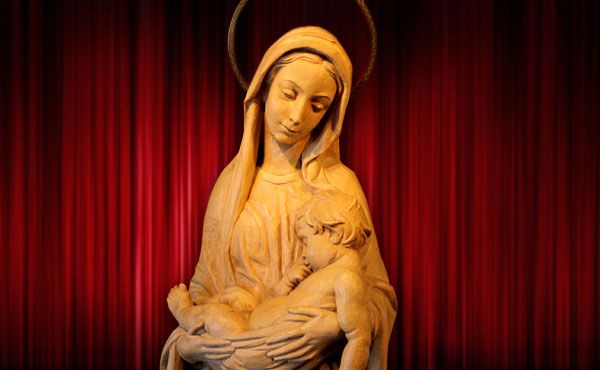The beauty of that face
It has probably happened to all of us in the last few months: We delay in recognising a friend or colleague because they are wearing a face-mask. We search high and low for our face-mask, only to realise some moments later that we are actually wearing it. We struggle to work out who has spoken to us because several people in front of us have the greater part of their face covered.
The current pandemic has many providential aspects. Perhaps one of these is the opportunity to rediscover the beauty of each and every human face, the unique face which reveals the unique person. What is more, we are created to contemplate and adore the Face with a capital “F”, the divine-human face of our loving Saviour. This is the only Face which ultimately satisfies us:
“My soul thirsts for God, for the living God. When shall I come and behold the face of God?” (Ps 42:2).
It seems clear that this Christmas will be more sedate and silent than those of other years. The Catechism of the Catholic Church (no. 2724) teaches us that “contemplative prayer is a gaze of faith fixed on Jesus, an attentiveness to the Word of God, a silent love”. Perhaps one of the graces of a “Covid-Christmas” may be a more serene and deeper contemplation of Christ who is, in the Holy Father’s words, Misericordiae Vultus, that is, “the Face of the Father’s Mercy” (Bull of indiction the Extraordinary Jubilee of Mercy, 11 April 2015).
We are indeed created to behold that Face. Contemplation of the Lord’s Face in this life is a certain beginning of the happiness of the beatific vision of that Face in the next (cf. St Thomas Aquinas, Summa Theologiae, II, II, 180, 4).
“My heart says to thee: ‘Thy face, Lord, do I seek’. Hide not thy face from me” (Ps 27:8-9).

A Face that reveals the gift of God
“Christianity is not just a book of culture or an ideology, nor is it merely a system of values or principles, however lofty they may be. Christianity is a person, a presence, a face: Jesus, who gives meaning and fullness to human life”. So spoke St John Paul II to young Swiss Catholics on 5 June 2004. On reading the same Pope’s Apostolic Letter on the Rosary, Rosarium Virginis Mariae (16 October 2002) one has the sense that there is an autobiographical element contained in the teaching it offers. “To look upon the face of Christ, to recognise its mystery amid the daily events and the sufferings of his human life, and then to grasp the divine splendour definitively revealed in the Risen Lord, seated in glory at the right hand of the Father: this is the task of every follower of Christ and therefore the task of each one of us. In contemplating Christ's face we become open to receiving the mystery of Trinitarian life, experiencing ever anew the love of the Father and delighting in the joy of the Holy Spirit” (RVM 9).
Shakespeare wrote that “there’s no art to find the mind’s construction in the face” (Macbeth I, IV). In Christ’s Face there is however no insincerity. He who sees him sees the Father (cf. Jn 14:9). The Face of Jesus is the transparent reflection of the Trinity’s love for each of us. “For the Son of God, Jesus Christ … was not Yes and No; but in him it is always Yes. For all the promises of God find their Yes in him” (2 Cor 1:19-20).
In the beautiful painting by the Dutch artist Matthias Stomer, The Adoration of the Shepherds (c.1635-37), the rugged faces of the shepherds are bathed in the light which streams from the face of the Christ Child which they contemplate. This “dialogue” is the vocation of each one of us, called to be contemplatives in the middle of the world, seeking out, discovering and savouring the Face of Jesus in our daily life, work, family, friendships, sufferings and joys. The time we spend contemplating this Face in the crib, on the crucifix or in the tabernacle will spill over into the rest of our activities no matter how busy we are. This is because contemplation is a question of love and when love is nurtured it grows. As Joseph Pieper puts it in his essay Happiness and Contemplation: “Contemplation is a loving attainment of awareness. It is intuition of the beloved object”.
Bringing joy to many faces
One of the mottos of the Dominican Order is “contemplata aliis tradere” (“to give to others what one has contemplated”). This phrase which is derived from the Summa Theologiae of St Thomas Aquinas (III, 40, 1 ad 1) can express the Christian apostolate in general. From contemplating the Face of Christ we get the light and strength to share the Gospel with others. Souls do indeed desire this Face. As Psalm 4:6 has it:
“There are many who say, ‘O that we might see some good! Lift up the light of thy countenance upon us o Lord!’”
Time spent quietly and alone before the Crib is not selfish, but rather reaches out to embrace all those who need and seek the Saviour. Our silent prayer before the Face of the Child can be a powerful apostolate towards many other people. As Pope Francis reminds us, “the primary reason for evangelizing is the love of Jesus which we have received” (Evangelii Gaudium 264). Our contemplation of the Face of Christ can become a blessing for all our friends and family. Our prayer for them could be the words the Lord gave to Moses to bless the people of Israel with:
“The Lord bless you and keep you: The Lord make his face to shine upon you, and be gracious to you: The Lord lift up his countenance upon you, and give you peace” (Numbers 6: 24-26).

The Face of the Mother
As we enter into the cave at Bethlehem this Christmas, we may well be struck by the young mother who accompanies her Child. There is something ineffably sublime about her, and at the same time utterly natural and attractive. We feel entirely at home in her company and realise, as it were instinctively, that the mother of this Child is also truly our mother. From her we learn to contemplate Him. In her face we see his Face.
“The contemplation of Christ has an incomparable model in Mary. In a unique way the face of the Son belongs to Mary. It was in her womb that Christ was formed, receiving from her a human resemblance which points to an even greater spiritual closeness. No one has ever devoted himself to the contemplation of the face of Christ as faithfully as Mary” (St John Paul II, Rosarium Virginis Mariae 10).
